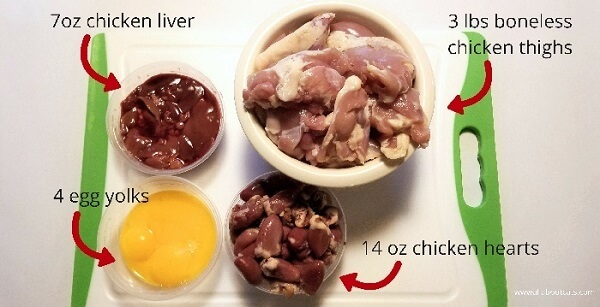In recent years, many pet owners have become more conscious about the quality of food they feed their pets.
This has led to a growing interest in raw diets for cats. Raw feeding involves providing cats with uncooked, natural foods that mimic the diet of their wild ancestors.
Advocates claim that it offers numerous health benefits, including improved digestion, healthier skin and coat, and increased energy levels.
The Basics of Raw Feeding
Raw feeding involves giving your cat a diet primarily made up of raw meat, bones, and organs. The idea is to mimic the diet of wild cats, which thrive on a prey-based diet.
Proponents of raw feeding argue that cats are obligate carnivores, meaning they need a diet that consists mainly of meat.
Raw feeding is a controversial but growing trend among cat owners who believe that a diet consisting mostly of raw meat, bones, and organs is the best way to meet their cat’s nutritional needs.
The concept behind raw feeding is to replicate the diet of wild cats, who rely on a prey-based diet to thrive.
Proponents of this feeding method argue that cats are obligate carnivores, meaning their bodies are designed to consume and digest meat more efficiently than plant-based foods.
Advocates of raw feeding claim that it provides numerous benefits for cats, including improved digestion, healthier skin and coat, increased energy levels, and better dental health.
They argue that commercial cat foods often contain a variety of additives, fillers, and grains that are not ideal for feline consumption.
However, it is important to note that raw feeding comes with potential risks and challenges. One major concern is the risk of bacterial contamination.
Which can lead to foodborne illnesses for both cats and their owners. Proper handling, storage, and hygiene practices are crucial to minimize these risks.
Additionally, raw feeding can be more time-consuming and expensive than feeding commercial cat foods.
It requires careful meal preparation, sourcing high-quality ingredients, and potential supplementation to ensure that cats receive a balanced and complete diet.
Ultimately, the decision to feed your cat a raw diet should be made after careful consideration, consultation with a veterinarian, and thorough research.
It is vital to weigh the potential benefits against the risks and determine what is best for your individual cat’s health and well-being.
The Benefits of a Raw Diet
Proponents of raw feeding claim that it offers numerous health benefits for cats. One of the main benefits is improved digestion.
Raw diets are free from the fillers and additives often found in commercial cat foods, which can be difficult for cats to digest. Additionally, the natural enzymes present in raw meat can help improve digestion.
These enzymes aid in breaking down proteins and other nutrients, making them easier for cats to absorb and utilize.
This can result in improved nutrient absorption and reduced digestive issues such as bloating, gas, and diarrhea.
Another advantage of raw feeding is its potential to promote a healthier weight in cats. Raw diets typically contain fewer carbohydrates than commercial cat foods, which are often high in grains and fillers.
Carbohydrates can contribute to weight gain in cats, as they are not an essential component of their diet.
By providing a diet that is more biologically appropriate and higher in protein, raw feeding can help cats maintain a leaner body condition and prevent obesity-related health problems.
Supporters of raw feeding also argue that it can enhance the immune system of cats. Raw meat and organs contain natural antioxidants, vitamins, and minerals that can strengthen the immune system and protect against various diseases.
Furthermore, proponents claim that feeding a raw diet can reduce the risk of allergies and allergic reactions in cats, as it eliminates common allergens like grains and artificial additives.
Additionally, raw feeding is often praised for promoting healthier skin and coat in cats. The high protein content in raw diets supports the growth of strong and shiny fur, while the absence of artificial colors and preservatives may reduce the risk of skin irritations.
Cats on raw diets are often reported to have reduced shedding and improved overall coat condition.
It is important to note that the raw feeding method requires proper handling and preparation to minimize the risk of bacterial contamination.
Raw meat should be sourced from reliable sources and handled with strict hygiene practices to ensure food safety for both cats and humans.
While proponents of raw feeding highlight these potential benefits, it is essential to consult with a veterinarian before transitioning a cat to a raw diet.
Each cat has unique nutritional needs, and a veterinarian can provide guidance and make recommendations based on the individual cat’s health and lifestyle.
Potential Risks and Considerations
While raw feeding can offer numerous benefits, it is important to be aware of the potential risks and considerations associated with this diet.
One of the main concerns is the risk of bacterial contamination. Raw meat can contain harmful bacteria such as Salmonella or E. coli, which can be detrimental to both pets and humans. It is important to handle and prepare raw meat safely to minimize this risk.
This includes keeping raw meat separate from other foods, using separate utensils and cutting boards, and washing hands thoroughly after handling raw meat.
Additionally, it is crucial to source high-quality raw meat from reliable sources to reduce the risk of bacterial contamination.
Another consideration is the nutritional balance of a raw-feeding diet. While raw meat can provide essential nutrients, it may be difficult to ensure a balanced diet without appropriate supplementation.
It is important to consult with a veterinarian or a pet nutritionist to ensure that the diet meets all of the pet’s nutritional needs.
Furthermore, raw feeding may not be suitable for all pets, especially those with certain health conditions. Some pets may have underlying health issues that can be exacerbated by a raw diet, such as pancreatitis or immune system disorders.
It is important to consult with a veterinarian to determine if raw feeding is appropriate for your pet’s specific needs.
Finally, raw feeding can also be more time-consuming and expensive compared to traditional pet foods. It often requires more preparation and careful meal planning to ensure a variety of meats and appropriate portion sizes.
Additionally, the cost of sourcing high-quality raw meat can be higher than commercial pet foods.
In conclusion, while raw feeding can offer potential benefits, it is important to be aware of the risks and considerations associated with this diet.
Proper handling and sourcing of raw meat, ensuring nutritional balance, considering specific health needs, and being prepared for the additional time and cost involved are all important factors to consider before deciding to feed your pet a raw diet.
Transitioning to a Raw Diet
If you decide to switch your cat to a raw diet, it is important to make the transition gradually. Cats can be sensitive to sudden dietary changes, so it is recommended to introduce raw food slowly, mixing it with their current diet.
Gradually increase the amount of raw food while decreasing the amount of commercial food over several weeks.
Conclusion
Raw feeding can be a beneficial and natural way to feed your cat. However, it is important to consider all the potential risks and consult with a veterinarian or animal nutritionist to ensure that your cat’s nutritional needs are met.
By providing a balanced and properly prepared raw diet, you can potentially improve your cat’s overall health and well-being.


